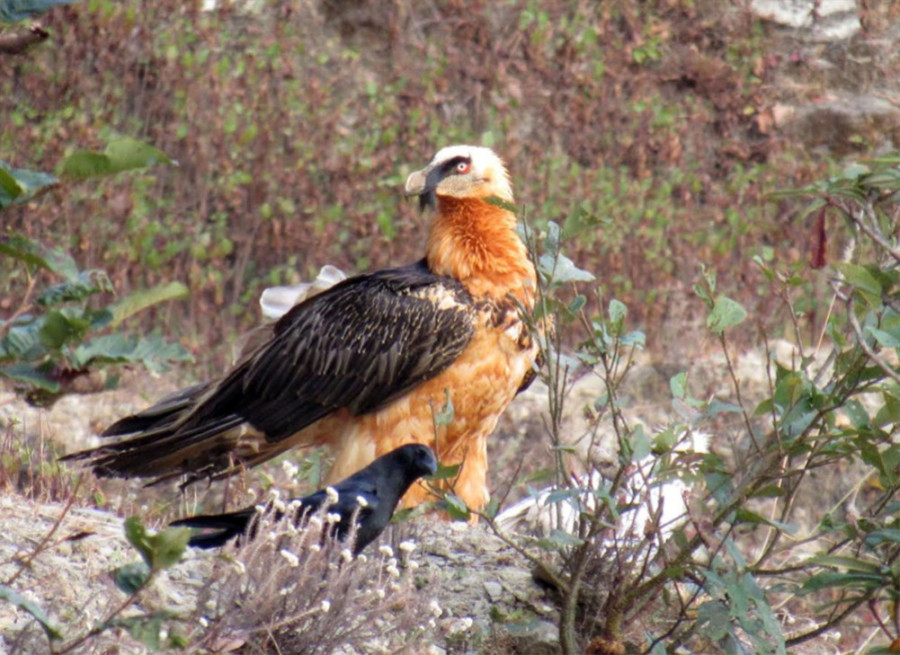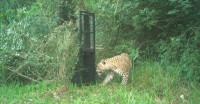Lumbini Province
217 bird species recorded in Pyuthan’s Gaumukhi areas
Known for its scenic beauty, forested hills and rich cultural heritage, Gaumukhi is emerging as a new hotspot for birdwatchers, nature researchers, and eco-tourists.
Shamsher Bikram GC
A scientific biodiversity study conducted in Gaumukhi Rural Municipality of Pyuthan, a hill district of Lumbini Province, has recorded 217 species of birds, solidifying the area’s status as a vital bird habitat in western Nepal.
The survey, carried out in two phases, in September-October 2024 and April-May 2025, documented a total of 4,538 birds of 217 species. The study was jointly conducted by ornithologists and researchers from the Himalayan Research Centre with support from the Gaumukhi Rural Municipality.
Among the rare finds were the globally endangered steppe eagle (Aquila nipalensis), locally known as Gomayu Chil—which migrates from Mongolia during the winter—and the demoiselle crane, also known in Nepali as Karyang-Kurung, a migratory species that flies southward over Nepal.
According to ornithologist and lead researcher Krishna Bhusal, the study revealed that out of the 217 recorded species, 99 are classified as conservation-priority species. This includes species that are globally threatened, nationally endangered or have very limited habitat ranges.
Notably, the Gaumukhi area is home to two of Nepal’s nine nationally protected bird species—the Himalayan monal (Lophophorus impejanus), Nepal’s national bird, and the elusive Cheer Pheasant (Catreus wallichii). The area is also the home to critically endangered vultures including the slender-billed vulture, red-headed vulture, white-rumped vulture, Himalayan griffon and bearded vulture.
The presence of 17 bird species categorised as “nationally endangered,” four species found in restricted geographical area and 69 species that are habitat-specific further emphasises the ecological significance of Gaumukhi area. Additionally, 31 of the bird species fall under the CITES (Convention on International Trade in Endangered Species) protected list.
The biodiversity survey extended beyond birds, recording other wildlife groups that highlight the ecological diversity of the area. Eight different species of butterflies, five species of freshwater fish, four species of amphibians, eight species of reptiles and 18 species of mammals have been recorded in the Gaumukhi area. Researcher Bhusal noted that the findings reflect Gaumukhi’s status as a biological hotspot and underline the urgent need to conserve the area.
The survey findings have further supported the local government’s effort to designate the Gaumukhi forest area as an official protected conservation area. This initiative, first proposed by the Department of Forests and Soil Conservation in 2016, would protect approximately 180.382 square kilometres of forestland within the rural municipality.
Speaking on the long-term significance of the study, vice-chairman of Gaumukhi Rural Municipality, Mahabir Rana, said that the Gaumukhi area offers an inspiring fusion of natural beauty, wildlife and cultural heritage—making it a unique destination for visitors seeking nature-based experiences. “This study is more than a record of species; it opens doors for ecological tourism, academic research, sustainable livelihood development and biodiversity preservation,” Rana said. “The bird census has motivated us immensely. It has shown the world that our municipality is a vital sanctuary for rare and migratory species.”
Local stakeholders have also emphasised the ecological and geographical significance of Gaumukhi’s forest belt. The area connects with the Madane Conservation Forest in Gulmi to the east, forest area in Baglung to the north, and the Kothibhir forest area of Pyuthan to the west. This positioning makes it a crucial ecological corridor for various species, including migratory birds.
Tulsiram Paudel, chief administrative officer of Gaumukhi Rural Municipality, said the biodiversity study provides scientific grounding to push for Gaumukhi’s formal recognition as a conservation area. “Beyond birds, the range of insects, fish, mammals and amphibians highlights the need to protect this natural treasure,” he said.
Paudel said that the local government is committed to balancing ecological preservation with economic upliftment through responsible tourism and community engagement. “By promoting conservation and sustainable tourism, we aim to create new opportunities for livelihoods and advance the holistic development of the municipality,” he added.
Known for its scenic beauty, forested hills and rich cultural heritage, Gaumukhi is emerging as a new hotspot for birdwatchers, nature researchers, and eco-tourists. Local officials believe that if current momentum is sustained, the region could become a model for community-based conservation and eco-tourism in Nepal.
With the increasing number of bird population and bird species, Nepal has been a haven for birding. Given the variety of bird species the country hosts, a good number of foreign tourists have started visiting the country, exclusively to watch birds.
Nepal is a home of 900 bird species after a new species of migratory seabird, known as short-tailed shearwater, was officially recorded in the country last month. The rare bird was spotted at the Koshi barrage reservoir in Saptari.




 15.12°C Kathmandu
15.12°C Kathmandu












